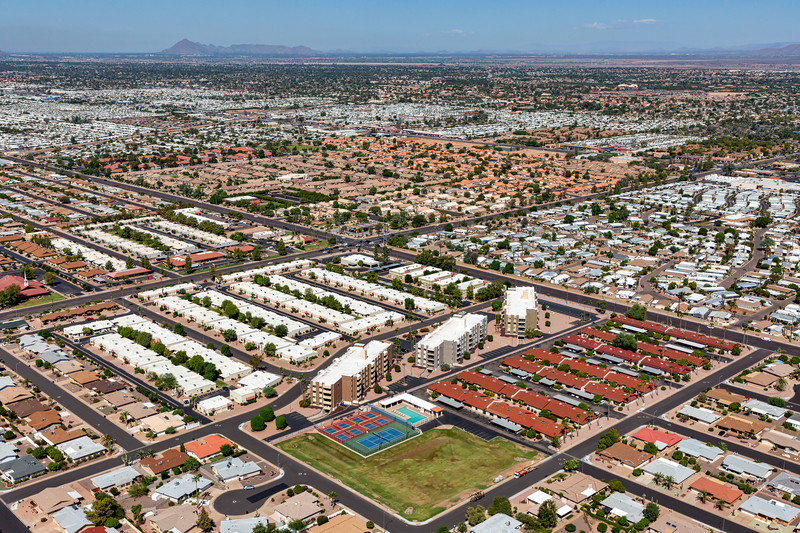
Photo: Timrobertsaerial | Dreamstime.com
‘No silver bullet’: Mesa tackles digital equity from multiple sides
23 May 2023
by Sarah Wray
When scanning the Federal Communications Commission’s latest broadband maps for funding opportunities, city staff in Mesa, Arizona struggled to find places that still needed access.

“Three years ago, there were pockets that lacked coverage throughout the city, says Harry Meier, Deputy CIO for Innovation at the City of Mesa.
“Now there’s nowhere in the city that doesn’t have something that meets the FCC criteria,” he comments.
He was speaking during an interview at the recent Cities Today Institute City Leadership Forum event in Las Vegas.
Meier talks about digital equity like the “legs of a stool”, describing how the city has tackled the issue from multiple angles.
Mesa’s diverse geography includes older neighbourhoods that lacked modern internet services as well as new developments with high-speed fibre. Some legacy providers had mixed coverage that was inconsistent from block to block, Meier says.
“There was already an acknowledgment pre-pandemic and we had been working to expand things like public Wi-Fi, and had programmes already set up and were working in that general direction,” he comments. “The pandemic just shone a light on everything, brought the funding from the federal government and fed us a lot of data.”
Targeting action
Previously, the city had some “assumptions” and data from the American Community Survey but during the pandemic, schools put out surveys to families to understand connectivity gaps.
“The school district’s survey data really lined up well with other data that we had from the census and what we knew about the neighbourhoods,” says Meier. “So that helped us target the areas that we needed to hit to get the best bang for our buck.”
The data showed around 10 square miles in the city with the highest need that also met low-income requirements for federal aid funding.
The city partnered with the school district and used CARES Act funding to buy around 7,000 laptops and 3,000 hotspots for students.
Building on this, Mesa is using American Rescue Plan Act (ARPA) funding to expand public Wi-Fi and bring private cellular coverage to the most underserved parts of the city,
The city partnered with Motorola to roll out a free Citizen Broadband Radio System (CBRS) network in priority areas. Over half of the 21 towers have been deployed so far.
“We also knew we can’t just put up CBRS and say, ‘OK, job done’,” Meier says.
The longer-term next step was about working with existing providers and attracting new ones.
In a bid to bring high-speed internet access to every home and business, Mesa updated its engineering code to allow micro-trenching, making it cheaper for providers to run fibre. In July 2022, following an RFI, the City Council approved licence agreements with Google Fiber, SiFi, Ubiquity and Wyyerd.
Some of the providers will operate an open access model, which gives residents access to a range of internet service providers. Those that use this model receive additional benefits from the city such as access to conduits, fibre and public utility easements.
“So now we have fibre to every home in the city rolling out over probably three or four years,” says Meier, adding that the deployment is “going gangbusters”.
Adoption
The last leg of the stool is wrapping a digital equity programme around all the work, to help people get online, including accessing subsidies, devices and training.
Mesa is working with Compudopt, which received a US$35 million multi-year grant from the Santander Consumer USA Inc. Foundation to provide free high-speed Internet connectivity, computers, training and support to eligible low-income residents in select cities.
“They’re knocking on doors, boots on the ground, distributing laptops and routers,” says Meier.
The city also plans to work with Compudopt to expand the CBRS network through an infrastructure-sharing agreement. This would double the capacity and speed of the CBRS network to support 4,000 users at 50 megabits pers second.
“When it comes to digital equity, there’s no silver bullet,” Meier concludes. “There are so many different pieces of the puzzle; we can’t do it alone.”
He adds: “You could stand up service and pat yourself on the back and then nobody could use it. We’ve seen that happen in a number of cities as well and even going back pre-pandemic to public Wi-Fi programmes; they’re always plagued with lack of use.
“You have to partner with your community anchor institutions, you have to be looking for those boots on the ground to knock on doors.”











